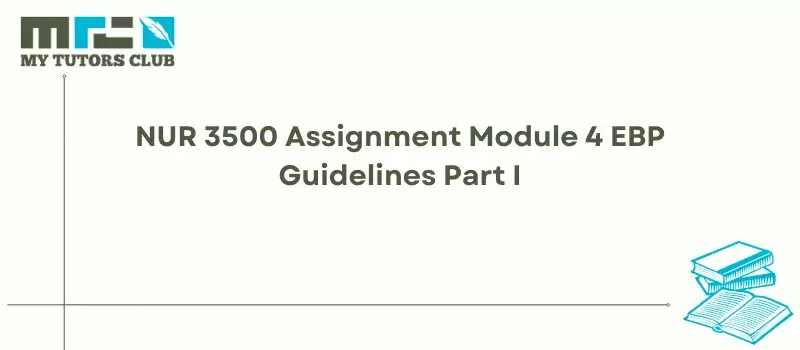Introduction
Medication errors are a persistent concern in healthcare, posing significant threats to patient safety and care quality. Addressing this issue through evidence-based practices is vital to improving healthcare outcomes (Aseeri et al., 2020). Barcode Medication Administration (BCMA) emerges as a highly effective tool among the strategies developed to reduce medication errors. BCMA integrates technology into medication verification and documentation, reducing medication type, dosage, or patient assignment errors.
This article introduces BCMA as a solution, discussing its role in minimizing medication errors, improving patient outcomes, and enhancing nursing efficiency. By exploring these aspects, the NUR 3500 Assignment EBP Guidelines Part I highlights the potential of BCMA to revolutionize medication management practices in healthcare.
Identifying a Clinical Problem
Understanding Medication Errors
Medication errors include incorrect prescriptions, improper dosages, and even failure to administer medication (Bengtsson et al., 2021). These errors can occur at various stages:
- Pre-transcription Phase: Errors in physician prescriptions.
- Transcription Phase: Mistakes during pharmacy documentation.
- Dispensing Phase: Incorrect drugs being handed out.
- Administration Phase: Errors during medication delivery to patients.
Causes include illegible handwriting, similar-sounding medication names, distractions, insufficient oversight, and inadequate patient education. The consequences can be severe, ranging from adverse drug reactions to extended hospital stays or even fatalities.
By leveraging evidence-based practices like BCMA, nurses can address these challenges head-on. This involves identifying error causes, implementing prevention strategies, and utilizing research-backed tools to foster safe medication practices.
PICOT Question
In hospitalized adult patients (P), does the implementation of barcode medication administration (I), compared to traditional manual medication administration (C), reduce the incidence of medication errors (O) within six months (T)?
- Patient/Population (P): Hospitalized adult patients.
- Intervention (I): Implementation of barcode medication administration.
- Comparison (C): Traditional manual medication administration.
- Outcome (O): Reduction in the incidence of medication errors.
- Time (T): Within six months.
Description of Research Topic and Background
The Case for Barcode Medication Administration
Medication errors are a global healthcare challenge, endangering patient safety and increasing healthcare costs (Gambhir et al., 2020). Traditional medication administration methods, such as handwritten documentation, are prone to errors like illegibility, incorrect dosages, and misidentification of patients.
BCMA addresses these issues by integrating barcoded medication labels with electronic medication administration records (eMARs). Nurses scan barcodes on medications, patients, and dosages, cross-referencing them with prescribed records to avoid errors (Mulac, 2021). Alerts for potential issues, such as drug allergies or interactions, further enhance safety.
Research supports BCMA’s effectiveness in reducing medication errors, adverse drug events (ADEs), and healthcare costs (Ho & Burger, 2020). Additionally, BCMA facilitates data analysis to identify recurring errors, enabling healthcare organizations to implement targeted improvements.
Purpose of the EBP Project
This NUR 3500 Assignment EBP Guidelines Part I project aims to evaluate BCMA’s effectiveness in reducing medication errors in hospitalized adult patients. This involves:
- Assessing BCMA’s impact on medication safety outcomes, such as error rates and ADEs.
- Comparing BCMA with traditional medication administration methods to identify strengths and weaknesses.
- Recommending evidence-based strategies for BCMA integration to improve medication safety in healthcare settings (Reale et al., 2023).
By systematically analyzing BCMA’s outcomes, the project aims to support its adoption as a best practice, ensuring safer and more efficient medication administration.
Significance of the Topic to Nursing Practice
Enhancing Patient Safety
Nurses are pivotal in preventing medication errors, as they oversee medication administration and patient monitoring (Linden-Lahti et al., 2021). BCMA enhances this process by reducing errors, such as administering the wrong drug or dosage and providing real-time alerts for potential issues.
Streamlining Workflow
BCMA simplifies error resolution, reduces redundant manual tasks, and optimizes nurses’ time for direct patient care. It minimizes the need for complex double-checking procedures, enhancing productivity and job satisfaction while reducing burnout.
Supporting Research and Quality Improvement
BCMA systems generate valuable data for analyzing error trends and improving medication guidelines. This information aids in advancing nursing practices and healthcare systems, contributing to better patient outcomes and a safer healthcare environment.
Conclusion
The NUR 3500 Assignment EBP Guidelines Part I underscores the critical role of BCMA in reducing medication errors and advancing nursing practice. By automating medication verification and documentation, BCMA minimizes risks associated with manual processes, ensuring safer patient care.
This research highlights BCMA’s broader benefits, including workflow efficiency and evidence-based practice improvements. As healthcare organizations invest in medication safety measures, BCMA represents a strategic solution for enhancing medication management and safeguarding patient health.
References
Aseeri, M., Banasser, G., Baduhduh, O., Baksh, S., & Ghalibi, N. (2020). Evaluation of medication error incident reports at a tertiary care hospital. Pharmacy, 8(2), 69. https://doi.org/10.3390/pharmacy8020069
Bengtsson, M., Ekedahl, A.-B. I., & Sjöström, K. (2021). Errors linked to medication management in nursing homes: An interview study. BMC Nursing, 20(1), 69. https://doi.org/10.1186/s12912-021-00587-2
Gambhir, R., Kuriakose, R., Aggarwal, A., Sohi, R., Goel, R., & Rashmi, N. (2020). Patient safety in primary and outpatient health care. Journal of Family Medicine and Primary Care, 9(1), 7. https://doi.org/10.4103/jfmpc.jfmpc_837_19
Ho, J., & Burger, D. (2020). Improving medication safety practice at a community hospital: A focus on bar code medication administration scanning and pain reassessment. BMJ Open Quality, 9(3), e000987. https://doi.org/10.1136/bmjoq-2020-000987
Linden-Lahti, C., Takala, A., Holmström, A.-R., & Airaksinen, M. (2021). What severe medication errors reported to health care supervisory authority tell about medication safety? Journal of Patient Safety, Publish Ahead of Print(17). https://doi.org/10.1097/pts.0000000000000914
Mulac, A. (2021). Barcode medication administration technology use in hospital practice: A mixed-methods observational study of policy deviations. BMJ Quality & Safety, 30(12), 1021–1030. https://doi.org/10.1136/bmjqs-2021-013223
Mulac, A. (2022). Medication errors in hospitals: Exploring medication safety through incident reports and observation of practice. Duo.uio.no. http://hdl.handle.net/10852/93260
Reale, C., Ariosto, D., Weinger, M. B., & Anders, S. (2023). Medication safety amid technological change: Usability evaluation to inform inpatient nurses’ electronic health record system transition. Journal of General Internal Medicine, 38, 982–990. https://doi.org/10.1007/s11606-023-08278-1




